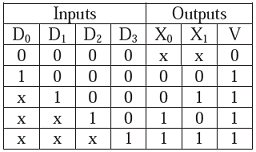GATE 2017-2018 :: GATE CSE
- A binary operation ⊕ on a set of integers is defined as x⊕y = x2 + y2 . Which one of the following statements is TRUE about ⊕?
- Suppose p is the number of cars per minute passing through a certain road junction between 5 PM and 6 PM, and p has a Poisson distribution with mean 3. What is the probability of observing fewer than 3 cars during any given minute in this interval?
-
In the following truth table, V = 1 if and only if the input is valid.
 What function does the truth table represent?
What function does the truth table represent? - Which one of the following is the tightest upper bound that represents the number of swaps required to sort n numbers using selection sort?
- Consider the languages L1 = φ and L2 ={a}. Which one of the following represents L1L2* ᴜ L3* ?
- What is the maximum number of reduce moves that can be taken by a bottom-up parser for a grammar with no epsilon- and unit-production (i.e., of type A → є and A → a) to parse a string with n tokens?
- A scheduling algorithm assigns priority proportional to the waiting time of a process. Every process starts with priority zero (the lowest priority). The scheduler re-evaluates the process priorities every T time units and decides the next process to schedule. Which one of the following is TRUE if the processes have no I/O operations and all arrive at time zero?
-
Match the problem domains in GROUP I with the solution technologies in GROUP II.GROUP I GROUP II(P) Service oriented computing (1) Interoperability(Q) Heterogeneous communicatingsystems (2) BPMN(R) Information representation (3) Publish-find-bind(S) Process description (4) XML
- The transport layer protocols used for real time multimedia, file transfer, DNS and email, respectively are


 Whatsapp
Whatsapp
 Facebook
Facebook



 ?
?  .
. .
. .
. .
.